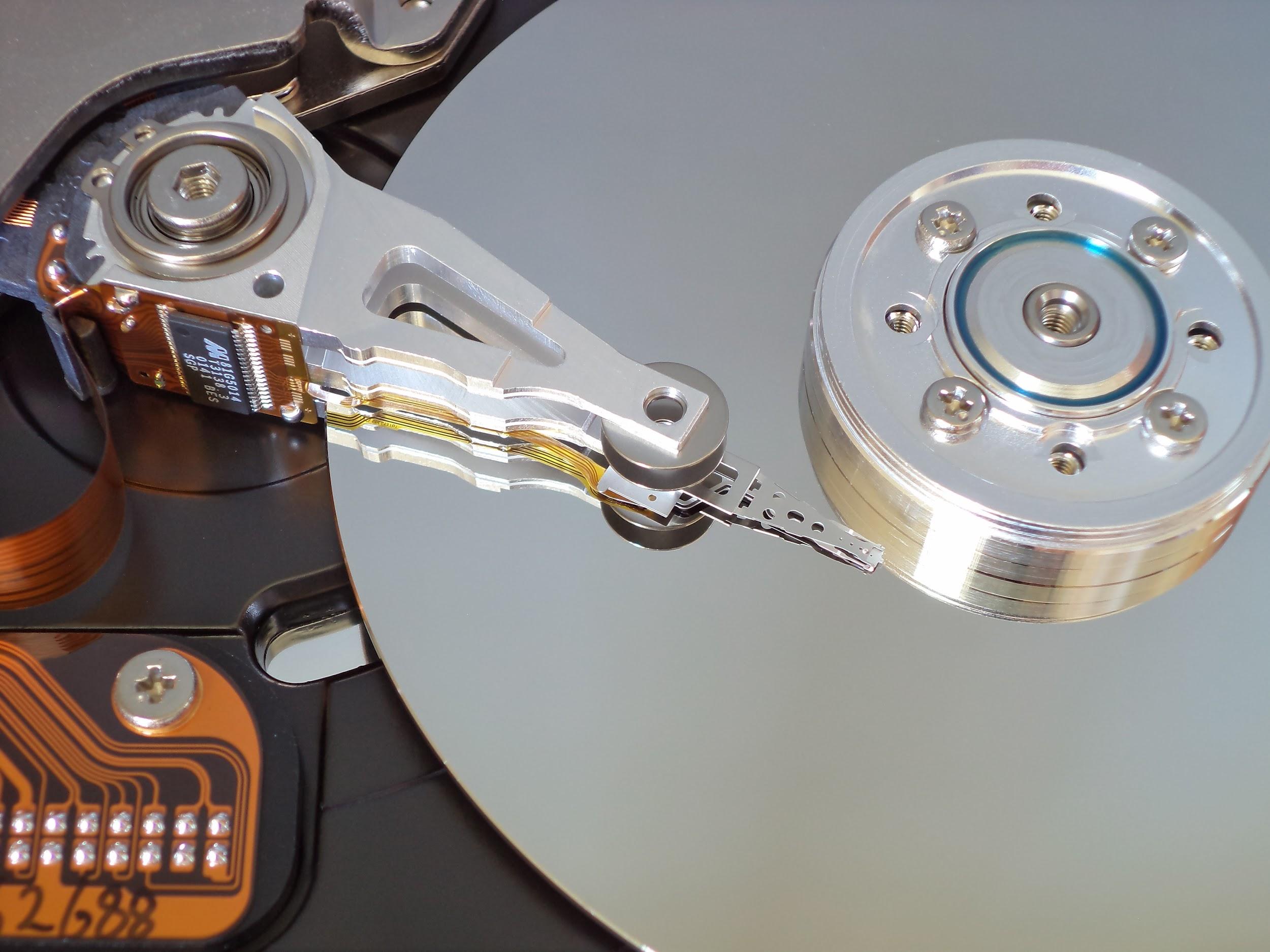
The world's first hard drive, the IBM RAMAC 305, which was released in 1956, contained only 5 MB of data, and at the same time weighed 970 kg and was comparable in size to an industrial refrigerator. Modern corporate flagships are capable of boasting a capacity of 20 TB. Just imagine: 64 years ago, in order to record such an amount of information, more than 4 million RAMAC 305 would be required, and the size of the data center required for their placement would exceed 9 square kilometers, whereas today a small box weighing about 700 grams! Much of this incredible increase in storage density has been achieved through advances in magnetic recording techniques.
It's hard to believe, but the design of hard drives has not fundamentally changed for almost 40 years, starting in 1983: it was then that the first 3.5-inch RO351 hard drive, developed by the Scottish company Rodime, saw the light. This toddler received two magnetic plates of 10 MB each, that is, was able to hold twice as much data as the updated 5.25-inch ST-412, released by Seagate in the same year for IBM 5160 personal computers.
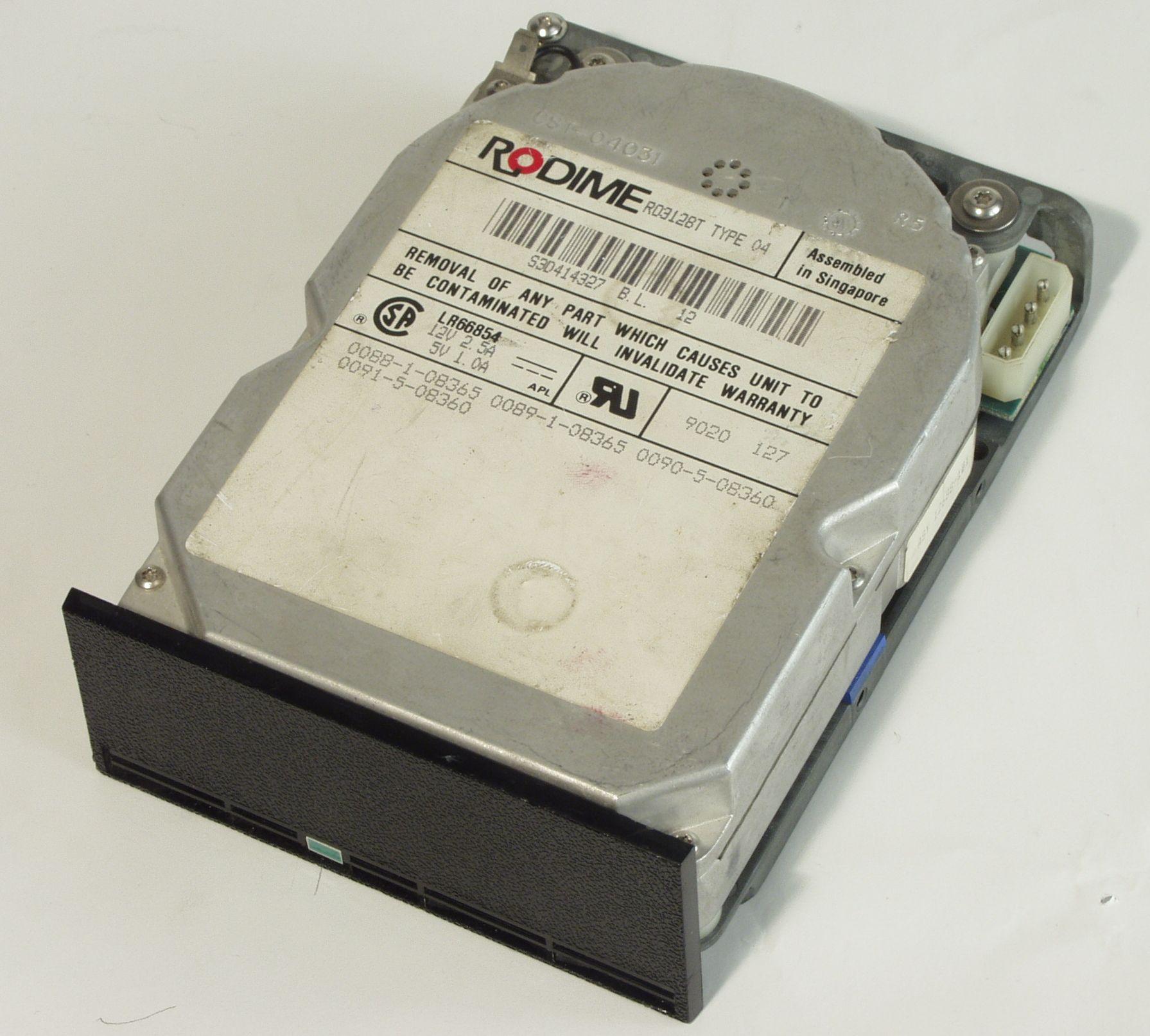
Rodime RO351 - the world's first 3.5-inch hard drive
Despite its innovativeness and compact size, at the time of its release, the RO351 turned out to be practically useless, and all further attempts by Rodime to gain a foothold in the hard drive market failed, which is why in 1991 the company was forced to cease its activities, having sold almost all available assets and reducing the staff to a minimum. However, Rodime was not destined to become bankrupt: soon the largest manufacturers of hard drives began to turn to it, wishing to acquire a license to use the form factor patented by the Scots. 3.5-inch is currently the accepted standard for both consumer and enterprise HDDs.
With the advent of neural networks, Deep Learning and the Internet of Things (IoT), the amount of data created by mankind began to grow like an avalanche. According to the IDC analytical agency, by 2025 the amount of information generated by both people themselves and the devices around us will reach 175 zettabytes (1 ZB = 10 21 bytes), and this despite the fact that in 2019 it was 45 ZB. in 2016 - 16 ZB, and back in 2006 the total amount of data produced in the entire foreseeable history did not exceed 0.16 (!) ZB. Modern technologies help to cope with the information explosion, among which advanced methods of data recording are not the last.
LMR, PMR, CMR and TDMR: what's the difference?
The principle of operation of hard drives is quite simple. Thin metal plates coated with a layer of ferromagnetic material (a crystalline substance capable of retaining magnetization even when it is not exposed to an external magnetic field at temperatures below the Curie point) move relative to the block of writing heads at high speed (5400 rpm or more). When an electric current is applied to the writing head, an alternating magnetic field arises, which changes the direction of the magnetization vector of the domains (discrete regions of the substance) of the ferromagnet. Data reading occurs either due to the phenomenon of electromagnetic induction (the movement of domains relative to the sensor causes an alternating electric current in the latter),or due to the gigantic magnetoresistive effect (the electrical resistance of the sensor changes under the influence of a magnetic field), as is implemented in modern storage devices. Each domain encodes one bit of information, taking a logical value "0" or "1" depending on the direction of the magnetization vector.
For a long time, hard disks have used the Longitudinal Magnetic Recording (LMR) method, in which the domain magnetization vector lies in the plane of the magnetic plate. Despite the relative simplicity of implementation, this technology had a significant drawback: in order to overcome coercivity (the transition of magnetic particles to a single-domain state), an impressive buffer zone had to be left between the tracks (the so-called guard space). As a result, the maximum recording density that was achieved at the end of this technology was only 150 Gbit / inch 2 .

In 2010, LMR was almost completely replaced by PMR (Perpendicular Magnetic Recording - perpendicular magnetic recording). The main difference between this technology and longitudinal magnetic recording is that the vector of the magnetic direction of each domain is located at an angle of 90 ° to the surface of the magnetic plate, which significantly reduced the gap between the tracks.
Due to this, the data recording density was significantly increased (up to 1 Tbit / inch 2in modern devices), while not sacrificing the speed characteristics and reliability of hard drives. Currently, perpendicular magnetic recording is dominant in the market, which is why it is also often called CMR (Conventional Magnetic Recording). It should be understood that there is absolutely no difference between PMR and CMR - this is just another version of the name.
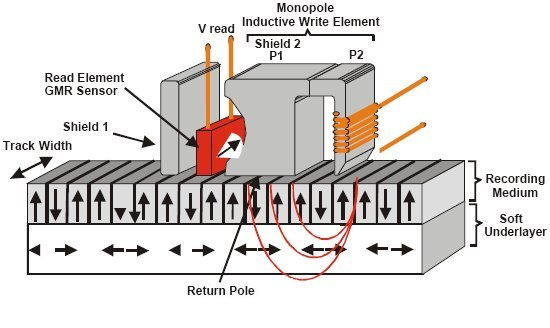
While studying the technical specifications of modern hard drives, you may also stumble upon the mysterious abbreviation TDMR. In particular, this technology is used by the enterprise-class Western Digital Ultrastar 500 series drives . From the point of view of physics, TDMR (which stands for Two Dimensional Magnetic Recording) is no different from the PMR we are used to: as before, we are dealing with disjoint tracks, the domains in which are oriented perpendicular to the plane of the magnetic plates. The difference between the technologies lies in the approach to reading information.
In the block of magnetic heads of hard drives, created using the TDMR technology, there are two readout sensors for each recording head, which simultaneously read data from each track passed. This redundancy enables the HDD controller to efficiently filter out electromagnetic noise caused by Intertrack Interference (ITI).
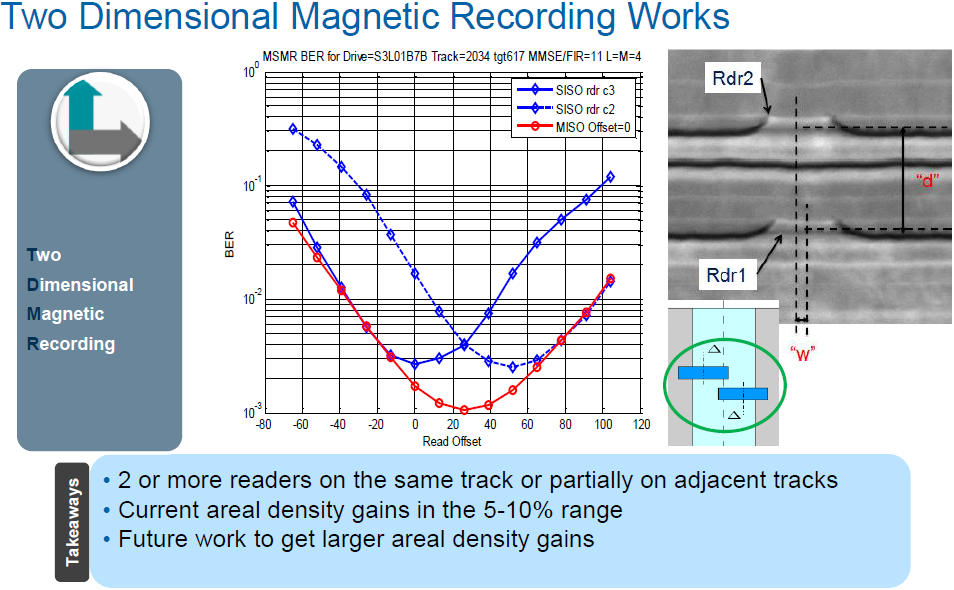
Solving the ITI problem provides two extremely important benefits:
- Reducing the Noise Ratio allows you to increase the recording density by reducing the distance between tracks, providing a gain in total capacity of up to 10% over conventional PMR;
- RVS , TDMR , , .
SMR ?
The size of the writing head is approximately 1.7 times the size of the readout sensor. Such an impressive difference can be explained quite simply: if the recording module is made even more miniature, the strength of the magnetic field that it can generate will not be enough to magnetize the domains of the ferromagnetic layer, which means that the data will simply not be saved. In the case of a readout sensor, this problem does not arise. Moreover: its miniaturization makes it possible to further reduce the influence of the above-mentioned ITI on the information reading process.
This fact formed the basis of Shingled Magnetic Recording (SMR). Let's figure out how it works. With traditional PMR, the head is offset from each previous track by a distance equal to its width + the width of the guard space.

When using the tiled magnetic recording method, the recording head moves forward only a part of its width, so each previous track is partially overwritten by the next one: the magnetic tracks overlap each other like a roof tile. This approach allows you to further increase the recording density, providing a capacity gain of up to 10%, while not affecting the read process. An example is the Western Digital Ultrastar DC HC 650 , the world's first 3.5-inch 20TB SATA / SAS drives, made possible by new magnetic recording technology. Thus, the transition to SMR drives allows you to increase the storage density in the same racks while minimizing the cost of upgrading the IT infrastructure.

Despite such a significant advantage, the SMR also has an obvious drawback. Since the magnetic tracks overlap each other, updating the data will require rewriting not only the required fragment, but also all subsequent tracks within the magnetic plate, the volume of which can exceed 2 terabytes, which is fraught with a serious drop in performance.
Combining a certain number of tracks into separate groups called zones helps to solve this problem. Although this approach to organizing data storage somewhat reduces the total HDD capacity (since it is necessary to maintain sufficient gaps between zones to prevent rewriting of tracks from neighboring groups), it can significantly speed up the data update process, since now only a limited number of tracks are involved in it.

Tiled magnetic recording suggests several implementation options:
- Drive Managed SMR (Drive Managed SMR)
Its main advantage is that there is no need to modify the software and / or hardware of the host, since the control of the data recording procedure is taken over by the HDD controller. Such drives can be connected to any system that has the required interface (SATA or SAS), after which the drive will be immediately ready for use.
The disadvantage of this approach is the variability in performance levels, which makes Drive Managed SMR unsuitable for enterprise applications where consistency of system performance is critical. However, such disks perform well in scenarios that allow sufficient time to perform background defragmentation of data. For example, WD Red DMSMR drivesOptimized for use in small 8-bay NAS systems, they are an excellent choice for archiving or backup systems that require long-term storage of backups.
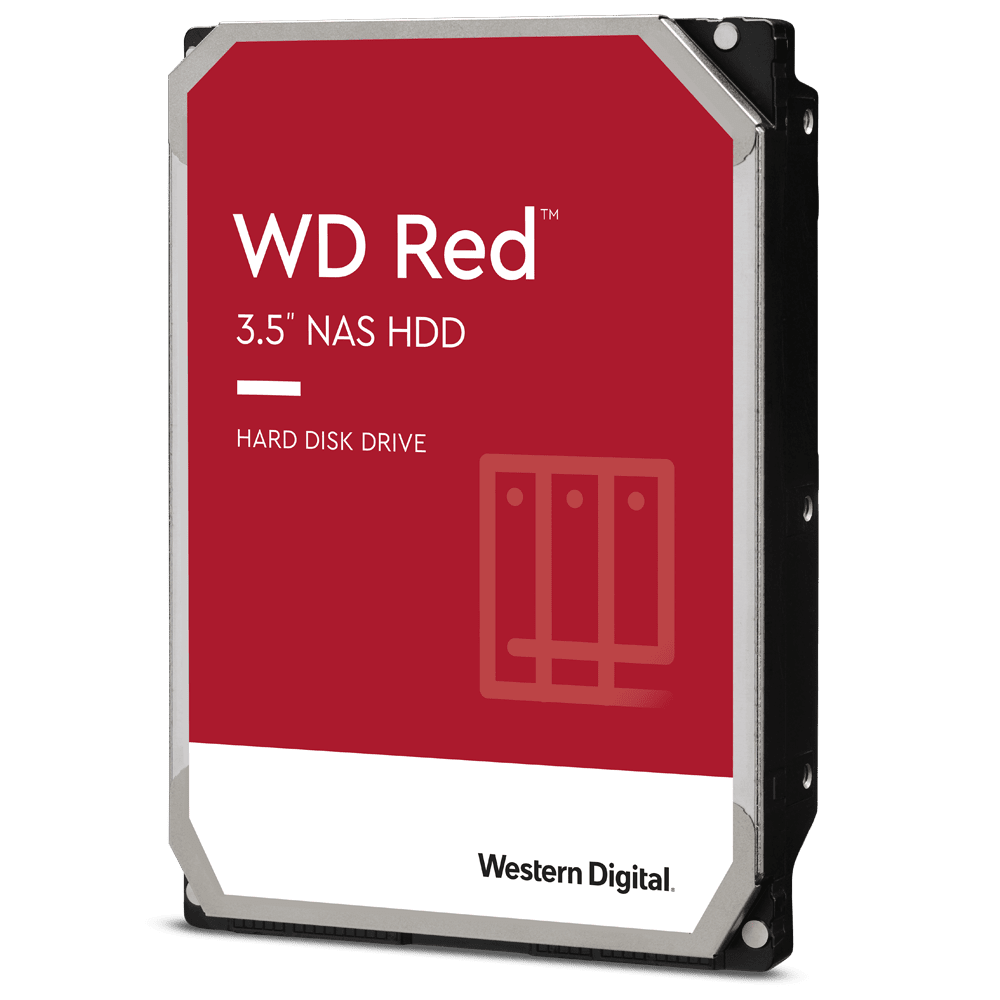
- Host Managed SMR (Host Managed SMR)
Host Managed SMR is the preferred tiled recording implementation for use in a corporate environment. In this case, the host system itself is responsible for managing data streams and read / write operations, using for these purposes the ATA (Zoned Device ATA Command Set, ZAC) and SCSI (Zoned Block Commands, ZBC) interface extensions developed by INCITS T10 and T13 ...
When using HMSMR, the entire available storage space is divided into two types of zones: Conventional Zones, which are used to store metadata and random writes (in fact, they act as a cache), and Sequential Write Required Zones, which occupy a large portion of the total hard disk capacity in which data is written strictly sequentially. The unordered data is stored in a cached area, from where it can then be transferred to the corresponding sequential write area. This allows all physical sectors to be written sequentially in the radial direction and overwritten only after cyclic transfer, which allows for stable and predictable system performance. At the same time, HMSMR disks support random read commands similarly to drives,using standard PMR.
Host Managed SMR is implemented in enterprise-class Western Digital Ultrastar HC DC 600 series hard drives .
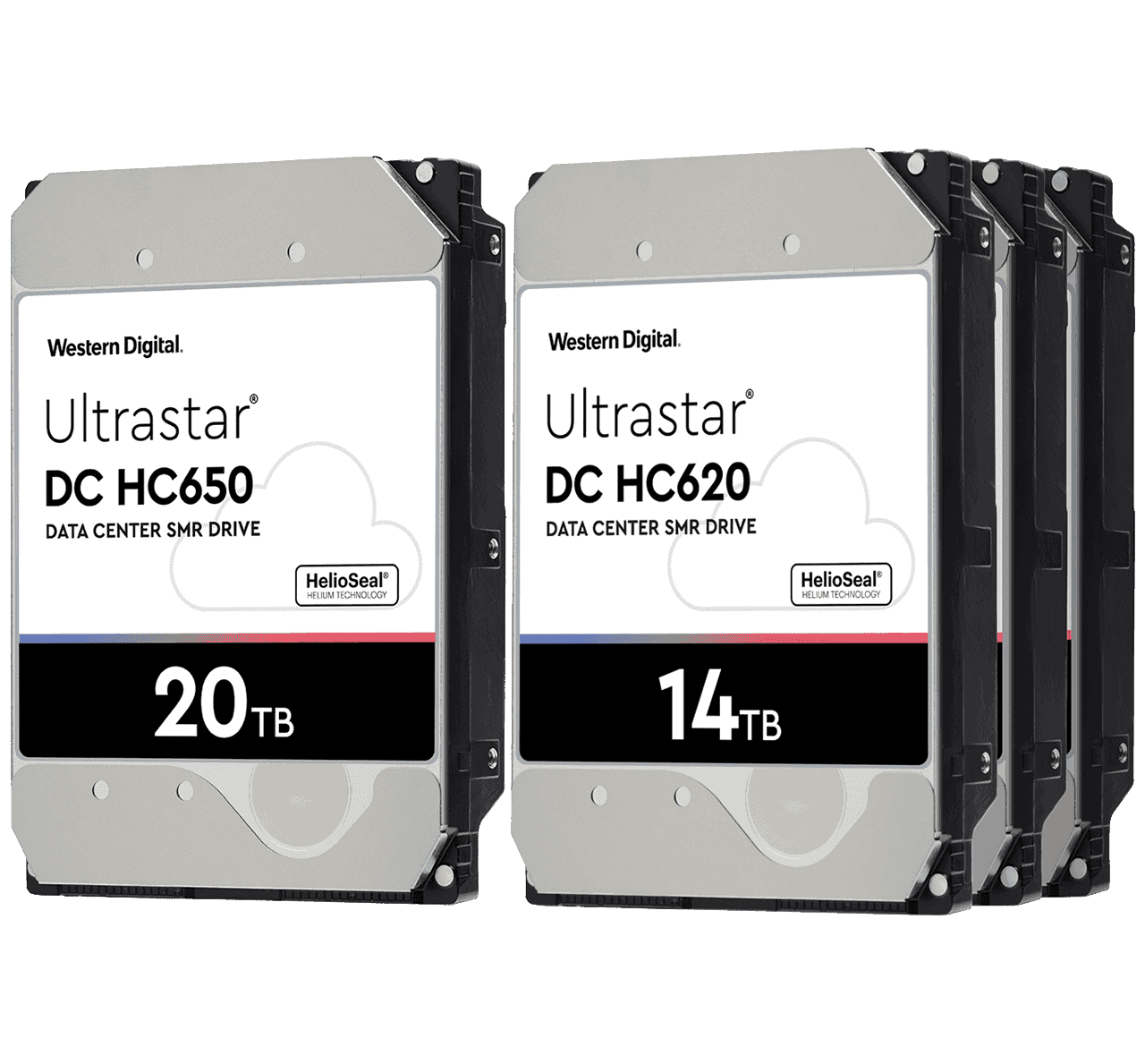
The line includes high-capacity SATA and SAS drives for use in hyperscale data centers. Host Managed SMR support significantly expands the scope of such drives: in addition to backup systems, they are perfect for cloud storage, CDN or streaming platforms. The high capacity of hard drives allows you to significantly increase storage density (in the same racks) with minimal upgrade costs, and low power consumption (no more than 0.29 watts for each terabyte of stored information) and heat dissipation (on average 5 ° C lower than that of analogs) - to further reduce the operational costs of maintaining the data center.
The only drawback of HMSMR is the relative complexity of implementation. The point is that today no operating system or application is able to work with such drives "out of the box", which is why serious changes in the software stack are required to adapt the IT infrastructure. First of all, this concerns, of course, the OS itself, which in modern data centers using multi-core and multi-socket servers is a rather non-trivial task. To learn more about options for implementing Host Managed SMR support , visit ZonedStorage.io , a dedicated zoned storage resource . The information gathered here will help you assess the readiness of your IT infrastructure for migration to zoned storage systems.
- Host Aware SMR (Host Supported SMR)
Host Aware SMR-enabled devices combine the convenience and flexibility of Drive Managed SMR with the high write speed of Host Managed SMR. These drives are backward compatible with legacy storage systems and can function without direct host control, but in this case, as with DMSMR drives, their performance becomes unpredictable.
Like Host Managed SMR, Host Aware SMR uses two types of zones: Conventional Zones for random writes and Sequential Write Preferred Zones. The latter, in contrast to the above-mentioned Sequential Write Required Zones, are automatically transferred to the category of ordinary ones in the event that an unordered data recording starts in them.
A host-assisted SMR implementation provides internal mechanisms for recovering from an inconsistent write. Unordered data is written to the cached area, from where the disk can transfer information to the sequential write area after all the necessary blocks have been received. The disk uses an indirection table to manage out-of-order writes and background defragmentation. However, if enterprise applications require predictable and optimized performance, this can still only be achieved when the host takes full control of all data streams and write zones.